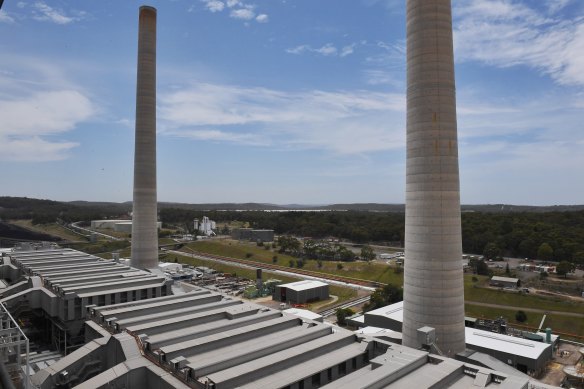‘Nightmare scenario’: Ageing coal power is driving up electricity bills
Unplanned outages at three east coast coal power stations in May contributed to soaring wholesale electricity prices, in a harbinger of the price hikes facing NSW and Victorian residents if ageing fossil fuel generators are forced to stay open longer because of delays to the renewable energy rollout.
The Australian Energy Regulator outlined the outages in a report last month on the number of events where the price per megawatt hour exceeded $5000. This occurred 19 times in the April–June period, almost all of them in NSW over a couple of days in May.

Eraring power station’s lifespan has already been extended once. The renewables sector warns it could happen again.Credit: Nick Moir
Eraring and Vales Point power stations had multiple unplanned outages, while Bayswater had planned downtime but was kept offline for almost a week longer than expected because of technical problems.
Tony Wood, director of the energy program at Grattan, said the reliability of coal power stations was also a problem in Victoria and Queensland. Outages have also hit Queensland’s Callide power station, and similar issues were reported in Victoria at AGL-owned Loy Yang in 2022.
“The incidence of unplanned outages over the last five years has been steadily increasing – you can’t point at one particular plant, but we do know that that’s just the nature of getting old,” Wood said. “These plants are no longer teenagers … they will become increasingly expensive to maintain, and there will be safety concerns as well.”
The AER report shows that price events over $5000 a megawatt hour caused a spike in the wholesale price for the second quarter, and also a rise in the futures rate paid by retailers or large industrial users to lock in deals for 2025. Wholesale prices also rose in the second quarter because of other factors, including cold weather increasing demand and a wind drought lowering supply.
Wholesale prices do not have an immediate impact on household bills, but they are factored in when the regulator adjusts maximum retail prices each year.
Wood said the outages pointed to the need to build renewable generation and transmission lines more quickly and for the Coalition to be clear about its plans for coal, gas and renewable power in the interim years if it expected nuclear energy to come online by 2037.
A national survey released on Thursday by Ipsos found 59 per cent of Australians supported moving from fossil fuels to renewables, while 17 per cent were opposed.
Pro-renewables consultancy NEXA Advisory recently published modelling, reported by this masthead, suggesting ageing coal power stations were increasingly unreliable towards the end of their lifespans, and it would cost consumers if they were forced to stay open because the replacement infrastructure had not been built.
NEXA Advisory chief executive Stephanie Bashir, a former senior director of public policy at AGL Energy, said the outages outlined in the AER report were a real-world demonstration of how delays would cost consumers.
Bashir said an orderly transition would mean that the renewable generation and required transmission were both built on time to enable the coal power stations to shut down as scheduled, but of the eastern states, only Queensland was on track.
“Currently, we’re on a disorderly transition because our transmission projects have all been delayed, especially the ones deemed as of national significance,” Bashir said.
“It’s really about Victoria and NSW … because they have the most coal power stations that are ageing and due to close over the next decade.”
The planned closure of Eraring was delayed by two years, from 2025 to 2027, in a deal between the NSW government and owner Origin. The next scheduled closure is Yallourn in Victoria, which Energy Australia plans to close in 2028. Then, in 2033, two NSW coal power stations, Vales Point and Bayswater, are due to close.
At a summit last week, Smart Energy Council chief executive John Grimes warned that the “real nightmare scenario” was that Eraring would be extended a second time because so many renewables projects were stuck in the planning system.
He said approvals for renewable projects took five to eight years and cost upwards of $1 million in NSW, compared with one year and $30,000 in Queensland and three to five years and $100,000 in Victoria.
“The [NSW planning] rules are being exploited to slow down and hamper progress,” Grimes said. “If you get more than 50 objections to a project, it’s automatically referred to the Independent Planning Commission, and Peter Pumpkin, 1000 kilometres away, can object.”
State energy ministers are consulting on an orderly exit management framework for the national electricity market to manage the retirement of coal power stations or to extend their lives where necessary. Bashir said this did not provide enough certainty about closure.
Wood said the wholesale price in one state affects the national energy market because when transmission is working normally, power is sold interstate. In May, NSW was hit by network outages that prevented it from accessing cheaper power from Victoria and Queensland.
Get to the heart of what’s happening with climate change and the environment. Sign up for our fortnightly Environment newsletter.